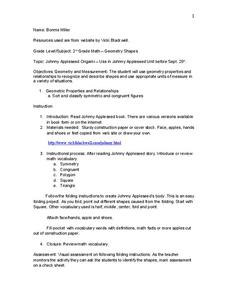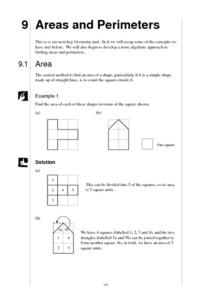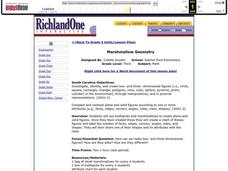Alabama Learning Exchange
Polygons-Changing Area Versus Changing Perimeter
Investigate the area and perimeter of polygons in this geometry lesson. Young geometers use grid paper to draw a quadrilateral and calculate its area and perimeter. They also read The Greedy Triangle to identify the changing shape of...
Curated OER
Transformations and Translations in Geometry
In this transformations and translations in Geometry worksheet, learners use geometric shapes and grids to translate six transformations in each of two activities.
Houghton Mifflin Harcourt
Unit 3 Math Vocabulary Cards (Grade 1)
Reinforce math vocabulary with a set of flashcards. Each card showcases a boldly typed word or a picture representation with labels. The topics are geometry related and include terms such as cones, faces, pyramids, sides, and...
Curated OER
Word Problem Practice Workbook
Need worksheets that challenge your middle schoolers to apply their understanding of math? Problem solved! From integers, fractions, and percents, to algebra, geometry, and probability, over 100 pages of word problem worksheets...
Curated OER
Does Your Field Measure Up
Students measure angles using a plane table kit. In this geometry activity, students use trigonometric identities to find the values of the length of a football field.
Curated OER
Mirror, Mirror
Geometry students use hinged mirrors to discover that the regular polygons are composed of triangles tessellating around a center point. They sketch triangles on paper models of the regular polygons having 3 to 10 sides and compute the...
Curated OER
Transformations - Rotations in the Coordinate Plane
In this geometry lesson, math scholars brainstorm examples of rotations. Using the SMARTboard, students observe a rotation. They create their own rotation using graph paper. Finally, pupils complete a worksheet and graph rotations.
Curated OER
Tessellations: Geometry and Symmetry
Students explore the concept of tessellations. In this tessellations lesson, students use an applet to construct tessellations. Students use regular polygons to construct tessellations. Students find patterns and symmetry in their...
Curated OER
Countdown Challenge: Platonic Solids - Part I
Use a Platonic solids worksheet to record the number of faces, edges, and vertices of five polyhedra whose faces, edges, and vertices are all identical. For each figure, learners write a proof of Euler's formula (F+V=E+2). They create a...
Curated OER
Geometry Practice: Loci and Transformations
This resource guides young geometers to create new polygons from others of equal area, compare an image to its reflection and find errors, conduct repeated reflections, map translations, and determine center of rotation. No solutions are...
Curated OER
Johnny Appleseed Origami
Second graders make an origami Johnny Appleseed. In this geometry lesson students follow folding instructions. They find different geometric shapes while they are folding. They create Johnny Appleseed's body and attach a face and hands...
Curated OER
My Test Book: Geometry
In this online interactive math skills worksheet, students solve 10 multiple choice math problems regarding geometry skills. Students may view the correct answers.
Curated OER
Calculating Distances in Two and Three Dimensions
Students use the Pythagorean Theorem to solve problems. In this geometry lesson plan, students solve for the distances by calculating the different parts of the shape of a two and three dimensional shape. They reason by analogy.
Exploratorium
Building Three-Dimensional Structures
Are you looking for a good 3-D geometry lesson that includes hands-on activities for your middle schoolers? Look no further than this one! Pupils use centimeter grid paper embedded in the plan, along with detailed construction...
Curated OER
Terrific Tangrams
Third graders construct tangrams. In this tangrams lesson, 3rd graders manipulate basic shapes to construct tangrams. Students explore how shapes can be combined in different ways and develop spatial sense.
Curated OER
Geometry Practice: Area of Polygons #9
In this area of polygons worksheet, students find the area of 12 polygons. Each shape is drawn on a grid. The area of each square on the grid is given. Problems are all multiple choice.
Curated OER
Two-Dimensional and Three-Dimensional Shapes
First graders explore 2-dimensional and 3-dimensional shapes. In this geometry lesson, 1st graders examine the attributes of 2 -dimensional and 3-dimensional shapes. They also create the shapes as they build models. This lesson...
Curated OER
Using Geometric Shapes in Architecture
Third graders identify two and three dimensional shapes used in architectural designs by viewing images on the Internet. In this geometry lesson, 3rd graders create their own building designs and identify the geometric shapes that...
Curated OER
Using Geometric Shapes To Make Patterns
Sixth graders explore the use of shapes to create geometric patterns. they start with a simple example of dividing shapes in half to create two new ones. This can be extended to creating intricate patterns.
Kuta Software
Identifying Solid Figures
Reinforce basic geometry skills in an elementary math lesson. A simple activity prompts learners to identify and label 3-D shapes.
Centre for Innovation in Mamatics Teaching
Areas and Perimeters
Cover some serious area in your geometry curriculum with this collection of worksheets. After first introducing the concept of area using the tiling method, this resource continues on to teach learners how to use...
Curated OER
Magician Squares
Elementary school learners investigate the attributes of a square. They discover that squares are polygons and examine squares found in everyday life. They concentrate on connecting the word, square, with the shape. As an...
Curated OER
Marshmallow Geometry
Third graders create 2D and 3D shapes using marshmallows and toothpicks. In this geometry lesson, 3rd graders create their shapes and document the number of faces, edges, corners, angles, and sides. They share one shape and its...
Curated OER
Solid Shapes
In this solid shapes worksheet, learners read descriptions of solid shapes, then label a set of pictures with either box, cylinder, pyramid or cone.

























